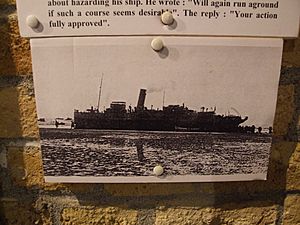PS Eagle III facts for kids

A photograph which had been left at the Dunkirk war memorial of the beached HMS Oriole (PS Eagle III).
|
|
Quick facts for kids History |
|
|---|---|
| Name |
|
| Owner |
|
| Operator |
|
| Builder |
|
| Launched | 14 April 1910 |
| Fate | Scrapped, 1946 |
| General characteristics | |
| Type | Paddle steamer |
| Speed | 16.5 knots |
PS Eagle III was a special kind of ship called a paddle steamer. It carried passengers on the River Clyde in Scotland. This ship was also used twice by the Royal Navy to clear dangerous mines from the sea during the two big world wars.
Contents
Building a Paddle Steamer
In 1909, a company called Buchanan Steamers wanted a new passenger ship. They ordered it from shipbuilders A. & J. Inglis in Glasgow. While Inglis built the engine and boiler, another company, Napier and Miller, built the main body of the ship.
Early Adventures and Fixes
The Eagle III was launched on April 14, 1910. It started carrying passengers that summer. However, on its very first trip from Glasgow to Rothesay, something strange happened. The ship leaned heavily to one side, almost putting one of its big paddle wheels completely underwater!
After this happened a few more times, the ship was taken out of service. Engineers fixed the problem by making the bottom of the ship wider. This made it more stable. The Eagle III was then ready to sail safely again in 1911.
Serving in the First World War
Many ships like the Eagle III were needed during the First World War. In 1917, the Royal Navy took over the Eagle III to use it as a minesweeper. Minesweepers are ships that find and remove dangerous underwater bombs called mines.
From Passenger Ship to Minesweeper
Before becoming a minesweeper, the Eagle III was changed. Its bridge, where the captain steers, was moved forward. This helped the crew see better and operate the ship for its new job. It was based in Grimsby during this time.
Back to Civilian Life
After the war ended in 1919, the Eagle III returned to the Clyde. Its owners, Buchanan Steamers, had joined with another company to form Williamson-Buchanan Steamers. The ship went back to its usual job, carrying passengers from Glasgow to Rothesay and Loch Striven.
About 15 years later, in 1935, the Eagle III and other ships from Williamson-Buchanan were bought by the Caledonian Steam Packet Company.
Heroic Actions in the Second World War
When the Second World War began in October 1939, the Royal Navy needed ships again. The Eagle III was taken for war duties once more, just like other Clyde steamers such as the PS Waverley.
Renamed for War Service
To avoid confusion with another ship named HMS Eagle, our ship was renamed HMS Oriole. It was changed again for war service. Its main passenger area was made smaller to make space for minesweeping equipment at the back. An anti-aircraft gun was also put on the front deck to protect it from enemy planes.
The Dunkirk Evacuation
In 1940, HMS Oriole and other minesweepers were sent to help with the Dunkirk evacuation. This was a huge rescue mission to save Allied soldiers trapped on the beaches of France.
When Oriole arrived at La Panne beach, its captain, Lieutenant E. L. Davies, saw that soldiers were struggling to get from the shallow beach to the ships. He made a brave decision to intentionally run the ship aground, or "beach" it.
This allowed the Oriole to act like a temporary pier. Soldiers could walk onto the ship and then get onto other boats more easily. The Oriole stayed beached for ten hours, even though it was open to attacks from the enemy. As the tide rose at dusk, the ship floated free and returned safely to Harwich.
The Oriole made four more trips to Dunkirk. It helped rescue 2,587 soldiers! For his brave actions, Lieutenant Davies received a special award called the Distinguished Service Cross.
Later War Service and End of an Era
In April 1941, HMS Oriole moved to Kingston-upon-Hull. In 1945, it helped deliver food supplies to the Netherlands during the Dutch famine.
After the war, the Eagle returned to the Clyde. However, it would have cost too much money to fix it up for passenger service again. So, the decision was made to take the ship apart. It was broken up in 1946 at the Smith & Houston yard in Port Glasgow.

